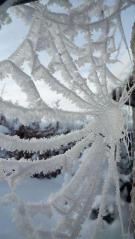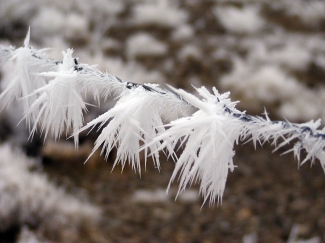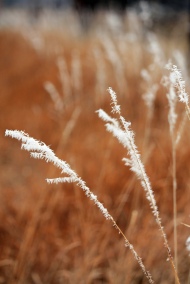Did you happen to catch the beautiful hoarfrost we had last Wednesday morning after our big ‘ole blizzard here in northeast Nebraska? As a new camera nerd, fumbling my way through learning my equipment, I was super bummed when on my way to work and filled with awe at the wintry spectacle I realized I had…yup you got it…forgotten my camera. I’m a new nerd. I repeat, new nerd.
Hoping to forecast my next photo opportunity I looked into the weather conditions that form hoarfrost. Let’s begin with something we are familiar with, dew point. Dew point is simply the temperature that water vapor needs to be cooled to saturate the air. Apparently you need constant pressure as well. I have a really interesting tangent about the differences in pressure between dew point and frost point but let’s stay on track here. When we have hit the dew point temperature, this is the point when relative humidity has reached 100 percent. All this means is the air cannot hold any more water. If the temperature drops below the dew point, water vapor will condense on grass, leaves or the iPhone you left out by the fire.
What does this have to do with hoarfrost you ask? I wanted to start with dew in relation to the formation of hoarfrost because I think we have all had experiences with dew. Think of a short walk through the grass in summer and arriving at work with soaked shoes. I took you on that little journey to get us to frost point.
Frost point is similar to dew point in that it represents the temperature at which air has been saturated. But rather than condensing on a surface, like dew, when saturated air bumps into a surface below 32 degrees, water vapor will jump straight from gas to a solid in a process call deposition. FANCY SCIENCE WORD! The opposite of deposition is sublimation, straight from a solid to a gas. (Think dry ice.)
So, when we have saturated air and solid surfaces that are below the freezing temperature of water we get frost. The size of those tiny crystals are determined by the amount of time they have been building up and the amount of water vapor in the air. This my friends, is when we get hoarfrost. Those conditions happen on cold nights with no insulation from clouds resulting in surfaces that are colder than the surrounding air.

Hoarfrost captured on a spider web. Image source
Keep your eyes out for our next hoarfrost, and hopefully I’ll be sharing some of my very own photos with you on our Nebraska Project WILD Facebook page.
Side note: DID YOU SEE THE LUNAR ECLIPSE THIS MORNING!?

